 “...... What I heard is as
good as, if not better, than vintage
hardware decoders - which rely
on obsolete and now-unobtainable
chips.” - Martin Pipe, October 2019
“...... What I heard is as
good as, if not better, than vintage
hardware decoders - which rely
on obsolete and now-unobtainable
chips.” - Martin Pipe, October 2019

“...... What I heard is as good as, if not better, than vintage hardware decoders - which rely on obsolete and now-unobtainable chips.” - Martin Pipe, October 2019
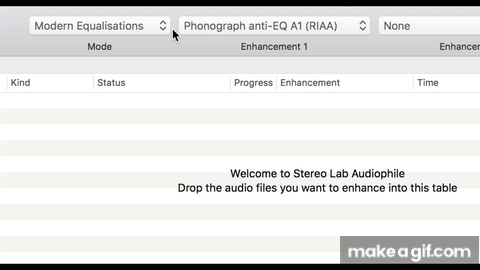
CD-4 stands for Compatible Discrete 4 Channel. This was a true four channel surround sound system for vinyl records. In America, the system was known as the RCA Quadradisc system. The system was launched in the early 1970s in Japan. In September 1971, RCA committed to adopting the JVC system in the USA and made initial releases in May of 1972.
Stereo Lab now supports software decoding of CD-4 quadraphonic LPs.
CD-4 (Quadradisc) has the 4th largest discography of commercial quad systems after: Dolby Surround; QS and SQ with about 150 titles released on the RCA label and about another 100 titles on other labels such as: A&M, Arista, Project 3, Atlantic and Electra/Asylum.
RCA's discography includes classical and country repertoire as well as a disproportionate share of easy listening. The label did eventually release CD-4 discs by mainstream acts, for example; Lou Reed and Nilsson. Nevertheless, light-jazz/ easy-listening repertoire dominates many of the releases on CD-4; aided by Project 3 which was a label devoted to this genre. This bias reflects the somewhat middle-aged demographic of the early-adopters of what was an expensive quadraphonic system. Warner Brothers' Elektra Asylum label released some of the biggest acts encoded in CD-4, including: The Doors; Bread; Joni Mitchell; The Eagles; and Bob Dylan.
“...... the development of a successful software-based decoder for CD-4 is a long standing goal - one that becomes more urgent each time another vintage, hardware-based decoder fails.” - Jim Austin, December 2019
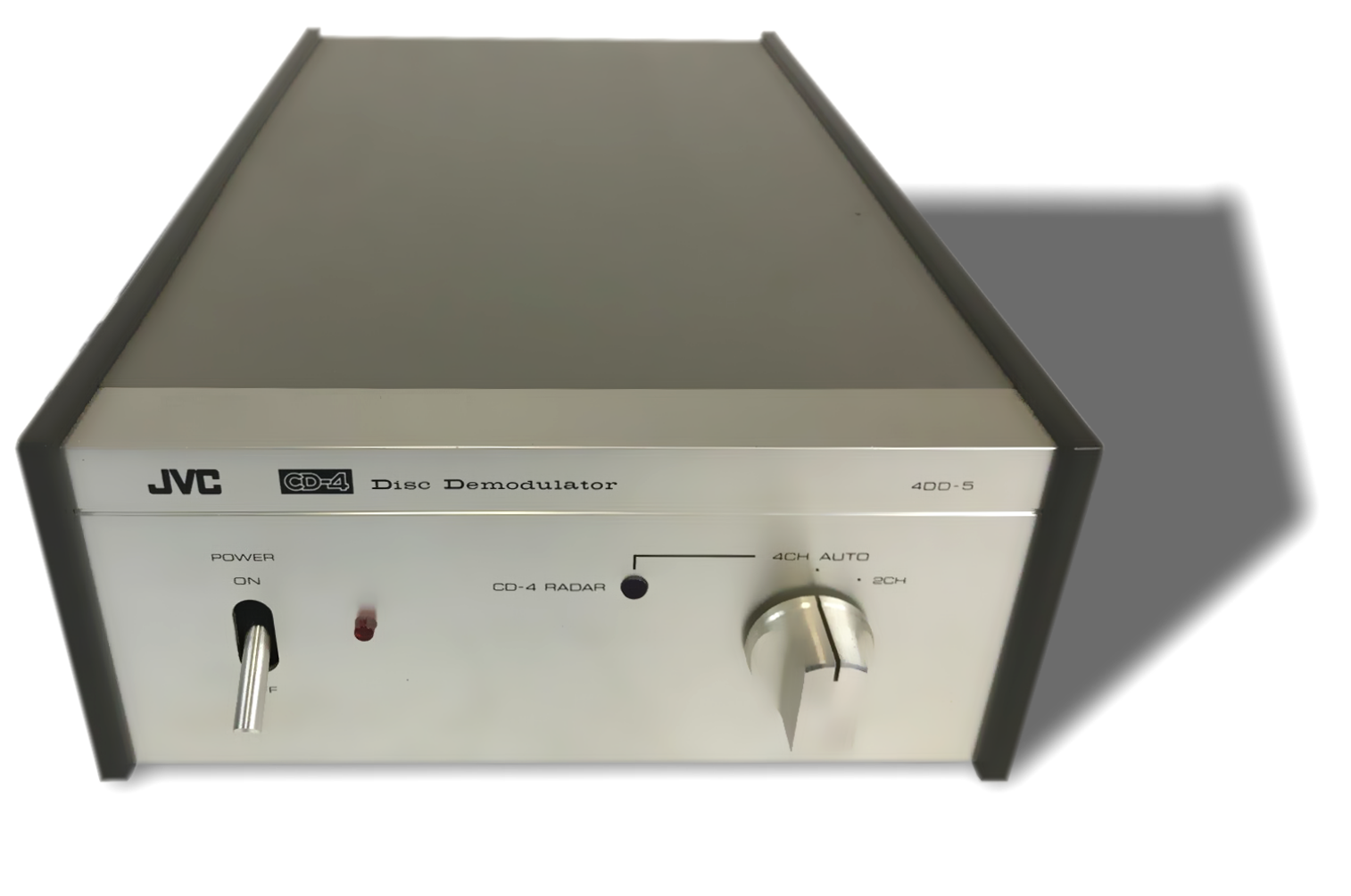 There exists an interesting parallel between the contemporaneous, rival, analogue television standards and the rival quadraphonic standards. Rather as with analogue television standards, a dimension exits which might be labelled quality vs. robustness when comparing the performance of the rival "quad" systems. Thus, a colour television standard like NTSC colour was capable of fine reproduction, yet it remained sensitive to channel distortions which made it a rather "fragile" system: whereas, the French SECAM system, whilst not capable of very fine reproduction, was so robust that colour TV signals could be passed (and even recorded) on monochrome equipment. Judged in this way, one can see that it's simply meaningless to declare one system as "best", since the question, "best for what?" follows inevitably.
There exists an interesting parallel between the contemporaneous, rival, analogue television standards and the rival quadraphonic standards. Rather as with analogue television standards, a dimension exits which might be labelled quality vs. robustness when comparing the performance of the rival "quad" systems. Thus, a colour television standard like NTSC colour was capable of fine reproduction, yet it remained sensitive to channel distortions which made it a rather "fragile" system: whereas, the French SECAM system, whilst not capable of very fine reproduction, was so robust that colour TV signals could be passed (and even recorded) on monochrome equipment. Judged in this way, one can see that it's simply meaningless to declare one system as "best", since the question, "best for what?" follows inevitably.
Matrix quadraphonic systems like QS and SQ can be seen as the "SECAM of quad": clever, robust with the extra information hidden in the same bandwidth of the audio and undemanding of replay equipment: whereas JVC's CD-4, whilst certainly the only system capable of real, discrete 4-channel performance, was a relatively fragile quadraphonic system. A number of requirements both of the equipment and the medium need to be fulfilled to derive a stable and realistic quadraphonic effect; conditions which are even harder to satisfy half-a-century on from the system's heyday!
Because of this, and because we can't control the quality of the hardware needle-drops applied to the software decode, Stereo Lab is designed to "fail gracefully" when those conditions are not satisfied. To achieve this, the decoder in Stereo Sauce converts the CD-4 signal to an intermediate Ambisonics B-format signal before the final loudspeaker signals are calculated. To do this has a number of important advantages as explained below.
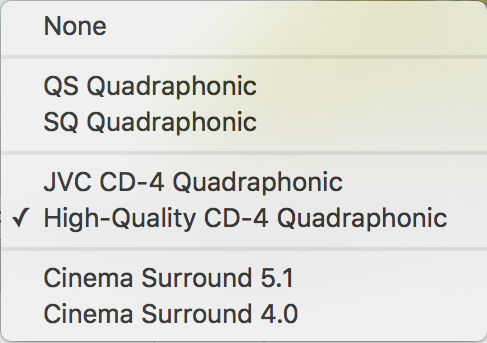 NEW! Classic CD-4 Decoder
NEW! Classic CD-4 Decoder
Pspatial Audio have introduced a new CD-4 decode mode in Stereo Lab versions. 3.1.13 and upwards. The new Classic CD-4 decoder has been developed in response to requests for a decoder which more closely emulates the hardware decoders of the 1970s. The decoder decodes to the four loudspeaker regular-polygon loudspeaker layout which was popular at the time. The Classic CD-4 decoder is selected as a processes in the Quadraphonic Decode mode options.
If distortion and noise are encountered when using this decoder: revert to the Pspatial Audio CD-4 decoder setting.
Baseband signals (20Hz - 15kHz) out of the groove are in fact the sum of the front and back signals (LF + LB) and (RF + RB). These signals are engraved on the 45° walls of the disc just as in a conventional stereo disc. The difference signals, used to separate back from front, are FM encoded on a pair of ultrasonic (30kHz) subcarriers above this baseband signal. (See diagram above.) The overall bandwidth of the CD-4 signal is thus from about 20Hz to 45kHz; a rather profligate three times greater than for conventional stereo LPs; a requirement which required CD-4 discs to be mastered at a third of normal speed.
A special Shibata stylus (alternatively named as Quadrahedral, Obata or Pramanik) is required to follow these high frequency subcarrier signals when the record is rotated at normal replay speed, and various precautions, such as: wide bandwidth preamps; correct cable types; low HF crosstalk in the cartridge and the subsequent electronics, are all required to recover subcarrier signals of sufficient and constant amplitude that successful decoding is possible. A micrograph of a recorded CD-4 groove illustrates the presence of the carriers as well as emphasising the concomitant requirement for scrupulously clean media and precision replay equipment.
Essentially, the CD-4 decoder in Stereo Lab has an Ambisonics "back-end".
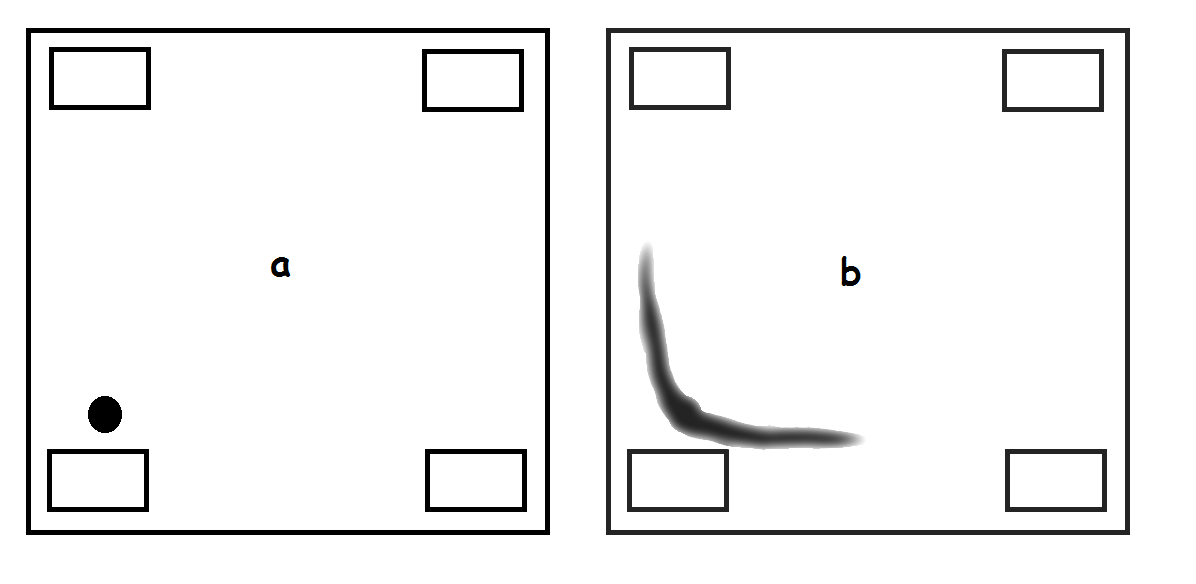 This is included because Ambisonics is a formalised description of a sound-field, so it is possible to control the adaption of the decoding on a more elegant basis than simply collapsing the front-back separation in the event that the recovery of the FM signals is not entirely successful (which is all the CD-4 standard allows for).
This is included because Ambisonics is a formalised description of a sound-field, so it is possible to control the adaption of the decoding on a more elegant basis than simply collapsing the front-back separation in the event that the recovery of the FM signals is not entirely successful (which is all the CD-4 standard allows for).
Our approach has been to recover an enjoyable and satisfying musical effect from CD-4 records for final presentation using the standard ITU-R BS. 775 5.1 surround-sound loudspeaker layout.
It is hoped that, in this manner, the decoder will be generally useful to a wide range of users with different standards of replay equipment and that these adaptive techniques will help redress some of the hostility towards the CD-4 system where it has sometimes gained the epithets, sandpaper quad or more generally seedy four.
Importantly, ONLY needle-drops at 96kHz sampling are acceptable for CD-4 decode in Stereo Lab. All other sample rates simply produce an error (Unsupported frame rate) and fail to process.
 Needle-drops must be be recorded without RIAA equalisation1. Attenuation of the upper sidebands of the CD-4 FM signals due to RIAA filtering is over 46dB relative to the baseband. Thus ninety-nine percent of the FM carrier level is lost in the RIAA filter and the FM tracks are reduced to 8-bit resolution. Our experiments have shown that reliable CD-4 FM carrier recovery is not possible with RIAA equalised needle-drops. (In any case, a non-equalised needle-drop is the usual input format for Stereo Lab phonograph processing and highly accurate RIAA correction to the baseband signals will be applied in software.)
Needle-drops must be be recorded without RIAA equalisation1. Attenuation of the upper sidebands of the CD-4 FM signals due to RIAA filtering is over 46dB relative to the baseband. Thus ninety-nine percent of the FM carrier level is lost in the RIAA filter and the FM tracks are reduced to 8-bit resolution. Our experiments have shown that reliable CD-4 FM carrier recovery is not possible with RIAA equalised needle-drops. (In any case, a non-equalised needle-drop is the usual input format for Stereo Lab phonograph processing and highly accurate RIAA correction to the baseband signals will be applied in software.)
JVC CD-4 decoding has its own preferences dialogue in the Stereo Lab GUI in which cartridge level matching and click-pop reduction may be selected. The initial CD-4 decoder is intended for CD-4 needle-drops of all CD-4 records, including those damaged in the fifty-odd years from their manufacture. A "best effort" approach is taken on the basis of the analysis of the incomming needle-drop data (as explained above).
Nota bene, by devoting a preferences dialogue to CD-4, we have provision to offer different decode "recipes" later. For example, we could offer a software decode which emulated exactly the old hardware systems with their maximum-separation decode to a four-square loudspeaker layout; something only desirable when a very high-quality CD-4 needle-drop is available.
Successful CD-4 decodes require some special requirements of the needle-drop hardware:
It is highly recommended that you use audio software such as Audacity* to record CD-4 needle-drops to the Mac. This software offers an instant view of the audio waveform as the needle-drop is made and the presence (or not!) of the 30kHz carrier is easily witnessed and judged; most obviously in silent sections where the presence of the subcarriers and their channel balance is easily inspected.
Using Audacity to record CD-4 discs also enables the correct recording levels to be set. CD-4 discs are recorded substantially quieter than conventional stereo discs, so be careful not to under-record CD-4 needle-drops. In fact, there is an excellent way to set CD-4 disc recording levels.6.
When looking at the waveform of an unequalised needle-drop (which is the only mode supported in Stereo Lab), the carrier should appear as a band of constant modulation.
The screen-grab below illustrates well the situation where, due to an incorrectly set skating-force adjustment, the carrier on the right channel (lower trace) is intermittent and inadequate for demodulation.
The state of cleanliness on CD-4 records is especially important. Cleaning CD-4 records is something of a specialist subject. We have found that standard methods should be considered a baseline for CD-4 types and that more Draconian methods are needed on discs which have been played many times.

If the quality of the ultrasonic subcarriers for either channels is judged inadequate, Stereo Lab will generate the warning "no RADAR" which appears in the process progress dialogue. (RADAR is the term JVC used for their carrier detection in the heyday of CD-4, so we use the term too; although what RADAR stands for in this context is not known.)
CD-4 difference signal processing is partially supended if this warning is given; although the full software decode is attempted and an output file(s) generated. Even in these circumstances, an attempt is made in the software to generate a partially valid surround-sound signal.
* Audacity is a free, easy-to-use, multi-track audio editor and recorder which runs on the Mac platform (and, in fact, on Windows and GNU/Linux too). Audacity is free software, developed by a group of volunteers and distributed under the GNU General Public License (GPL).
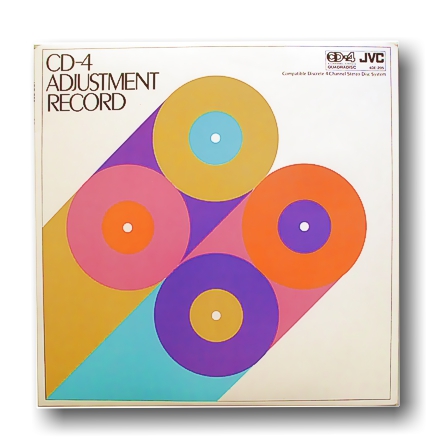 The matrix section in a standard CD-4 hardware decoder simply sums the FM signals and the baseband signals to generate the forward pair of signals and subtracts them to generate the rear pair of signals.
The matrix section in a standard CD-4 hardware decoder simply sums the FM signals and the baseband signals to generate the forward pair of signals and subtracts them to generate the rear pair of signals.
Our alternative approach in Stereo Lab is to derive the three (B-format) signals of first order, horizontal Ambisonics from the four CD-4 component signals. This enables us to exploit the power of Ambisonics to decode to different loudspeaker layouts. Using this technique, the CD-4 decoder in Stereo Lab decodes CD-4 to a standard, modern ITU-R BS. 775 5.1 surround-sound loudspeaker layout.
Hardware decoders require adjustment of the FM/baseband sensitivity; usually via a couple of potentiometers on the rear of the CD-4 decoder case. These are adjusted using signals from a special test record which was supplied with the unit. In Stereo Lab, no such special material is required and this adjustment is made automatically.
A short demo is available in the Phaedrus Audio listening room.
The input file to the CD-4 decoding process should be simple, two-channel, non-equalised, stereophonic track derived from the LP replay (or other source) at 96ksps ONLY. The output may be selected to be separate mono files (useful if you want to re-encode in DTS for example), or as a group of stereo files encoded:
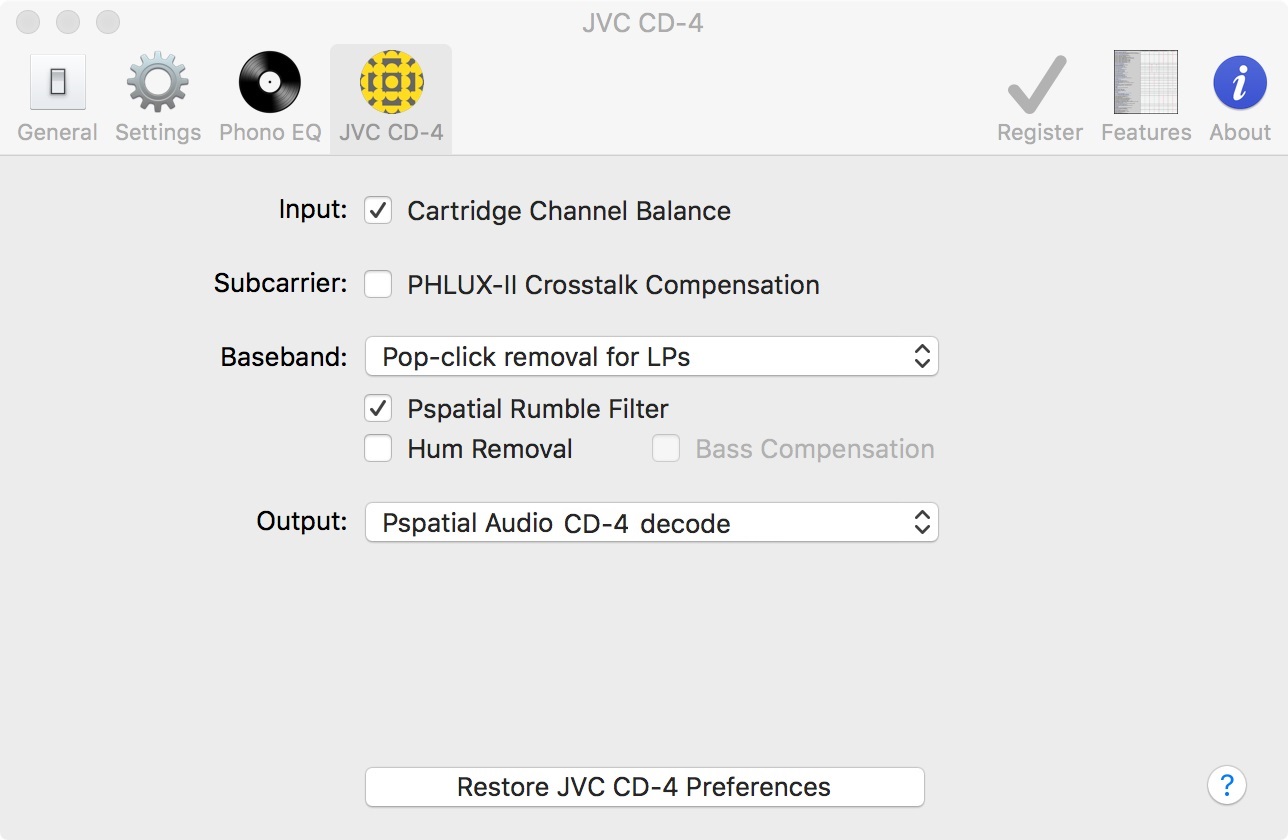
The CD-4 preferences tab groups together the controls for the various CD-4 decoding options in Stereo Lab.
Cartridge Channel Balance works by adjusting the measured RMS values of the left and right baseband signals. Note the points above concerning subcarrier quality and imbalance due to disc damage or due to a setup problem (like an incorrect anti-skate force) .
PHLUX-ll Crosstalk Compensation Only check this box is you are making needle-drops with the custom version of Phædrus Audio's PHLUX-II Libre active phono cartridge, fitted with a Shibata stylus. We could offer compensation for other cartridges here. See Output below for more information.
Pop-click removal for LPs Click-pop reduction systems are possible when decoding CD-4 The low recorded level of CD-4 baseband makes this noise-reduction especially useful.
Rumble filter Unless for test purposes, rumble filtering should always be selected as subsonic frequency components can upset the FM discriminator in CD-4 processing.
Hum Removal CD-4 needle drops should be substantially free of hum unless there is some major fault in the system. Only check this box if hum is not removed by other means.
Output For the moment, three output decodes modes are available: Pspatial Audio CD-4, which is the decode described above; CD-4 Classic, which is explained here; and Rears as Subcarrier.
If this last decode option is selected, the rear output audio signals are replaced by the filtered L/R subcarrier signals. This is intended for engineering purposes only. For example, this decode could be used to establish the quality of (or lack of damage to) the record or to check for "up-talk" from the baseband. It could also be used to measure cartridge crosstalk using the Shure Brothers square-pattern crosstalk test. The Shure Brothers test requires an audio goniometer (which is present in many DAWs). It is a simple and accurate way to measure crosstalk between the two subcarriers in a CD-4 system, including the cartridge.7
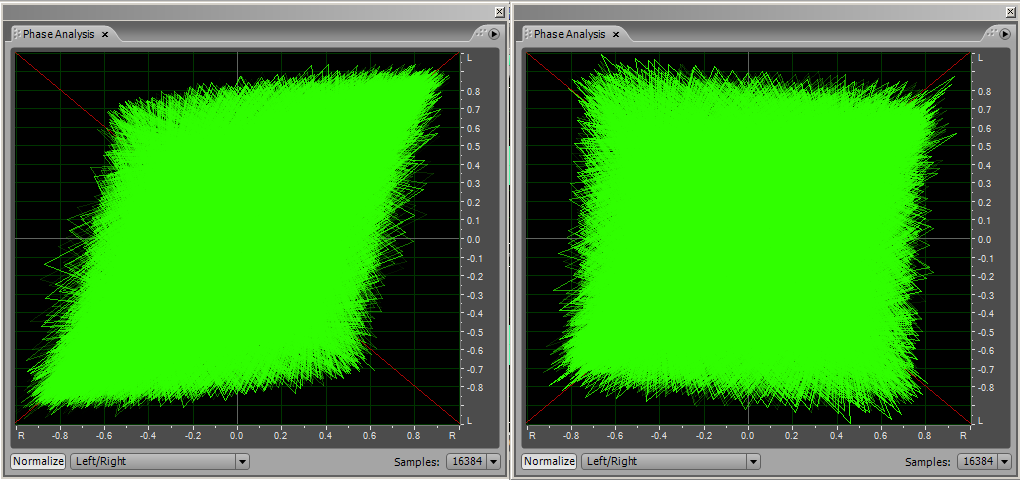
Pspatial Audio have received much help and advice in the development of this decoder. Thank you to all who have contributed ideas and samples of CD-4 material. We should especially like to thank Kirk Bayne and Jonathan Gatarz for their invaluable help.
Stereo Lab's CD-4 decoder is described in an engineering report in the Journal of the Audio Engineering Society.8
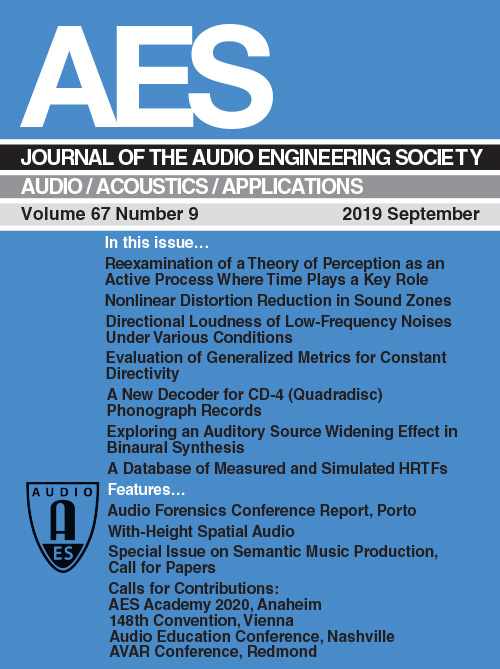
1. Tucked away in the original reference relating to CD-4 is the information that all the "extra" subcarrier information is recorded constant-velocity. The diagram below indicates this detail that the modulator equaliser compensates with a downward slope for the upward slope of the RIAA equaliser in cutting. So, the unequalised signal directly from a MM or MC cartridge has the correct frequency balance to ensure the upper and lower sidebands are correctly balanced. This is why an unequalised needle-drop is preferred.
A DISCREET FOUR-CHANNEL DISC AND ITS REPRODUCING SYSTEM (CD-4 SYSTEM), Inoue, T. et al. Presented at the 39th Convention of the AES, October 1970. The manuscript for the presentation was expanded and revised in March 1971 and appeared in the JAES July/August 1971 (title unchanged).
2. Maranz Model CD-400 Service Manual.
3. Build a High-Performance CD-4 Demodulator. Dorren, L. Popular Electronics September 1975 (illustration above)
4. Surround Sound Decoders 1 & 2. Heller, D. Wireless World June, July 1976
5. Recording characteristic of the CD-4 FM channels (from Reference 1). If performance from these channels really delivered 74dB dynamic range in a practical decoder, noise reduction would not be required.
6. Comparing the recording levels of standard stereo and CD-4 discs is complicated by inconsistent use of RMS and peak velocity values in the various references. Standard level for a normal, stereo LP is 3.54cm/s. This is an RMS figure and relates to a single stereo channel. If both channels are recorded at standard level, the resulting velocty is the vector sum of the two individual channel velocities. Because the channels are inscibed on two, perpendicular groove walls is equivalent to the root of the sum of the squares of the individual velocities (Pythagoras' theorem). Thus,
√(3.542 + 3.542) = 5cm/s.
It's easy to get this mixed up with the peak velocity which relates to the RMS value of 3.54 cm/s which is, of course,
√2 × 3.54cm/s = 5cm/s.
But these two values are quite different from each other.
The CD-4 "standard" (the nearest thing we have appears to be Ref. 1) sets standard recording level at 2.23cm/s probably RMS and for one channel. So, CD-4 level is,
2.23/3.54 = 0.63 , or 4dB below standard level on a stereo disc.
Each, unmodulated carrier is recorded at a velocity of 3.54cm/s and thus appears (because it appears before the baseband moduation) as a signal at exactly reference level when recording a non-equalised needle-drop. In fact, this is an excellent way to set recording-level for a CD-4 disc (provided it is known that the cartridge has an extended frequency response).
7. Carrier Crosstalk Considerations in the CD-4 System. Anderson, C.R. JAES July/August 1977
8. A New Decoder for CD-4 (Quadradisc) Phonograph Records. Brice, R. J. Audio Eng. Soc., vol. 67, no. 9, pp. 679–690, (2019 September.). DOI: https://doi.org/10.17743/jaes.2019.0016
 Home page
Home page
For all support issues, go here.
For Pspatial Audio sales, email: sales@pspatialaudio.com
